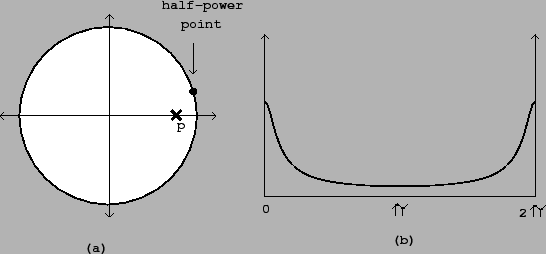 |
The one-pole low-pass filter has a single pole located at a positive real
number ![]() , as pictured in Figure 8.12. This is just a recirculating
comb filter with delay length
, as pictured in Figure 8.12. This is just a recirculating
comb filter with delay length ![]() , and the analysis of section
7.4 applies. The maximum gain occurs at a
frequency of zero, corresponding to the point on the circle closest to the
point
, and the analysis of section
7.4 applies. The maximum gain occurs at a
frequency of zero, corresponding to the point on the circle closest to the
point ![]() . The gain there is
. The gain there is ![]() . If we move a distance of
. If we move a distance of ![]() units
up or down from the real (horizontal) axis, the distance increases by a
factor of about
units
up or down from the real (horizontal) axis, the distance increases by a
factor of about ![]() , and so we expect the half-power point to occur at
an angular frequency of about
, and so we expect the half-power point to occur at
an angular frequency of about ![]() .
.
This calculation is often made in reverse: if we wish the half-power point to
lie at a given angular frequency ![]() , we set
, we set ![]() . This
approximation only works well if the value of
. This
approximation only works well if the value of ![]() is well under
is well under ![]() ,
as it usually is in practice.
,
as it usually is in practice.
It is customary to normalize the one-pole lowpass filter, multiplying it by
the constant factor ![]() in order to give a gain of 1 at zero frequency;
nonzero freqencies will then get a gain less than one.
in order to give a gain of 1 at zero frequency;
nonzero freqencies will then get a gain less than one.
The frequency response is graphed in Figure 8.12 part (b). The
audible frequencies only reach to the middle of the graph; the right-hand
side of the frequency response curve all lies above the Nyquist frequency
![]() .
.
The one-pole lowpass filter is often used to smooth noisy signals to seek slow-moving trends in them. For instance, if you use a physical controller and care about changes on the order of 1/10 second or so, you can smooth the control by using a low-pass filter whose half-power point is 20 or 30 cycles per second.